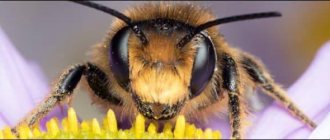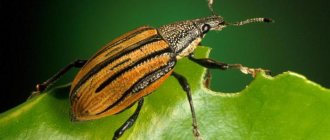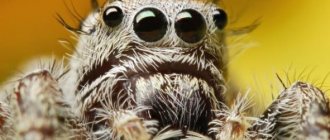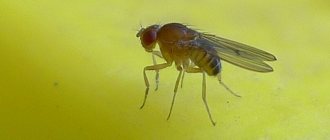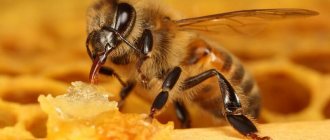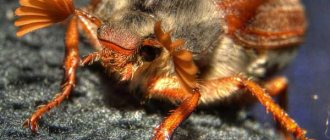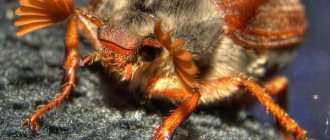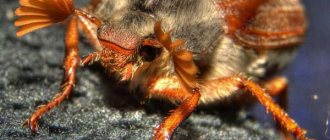Viktor Gloopov “Science at First Hand” No. 2(50), 2013
Among insects, the most developed eyes are those that are active during the day, such as flies and dragonflies. Up
— four-spotted dragonfly (
Libellula quadrimaculata
) with huge compound eyes;
on the left
is a section of the compound eye of a sylph fly from the genus
Cheilosia
. Scanning electron microscopy. Photo by R. Dudko (IS&EZh SB RAS, Novosibirsk)
It is believed that a person receives up to 90% of knowledge about the outside world with the help of his stereoscopic vision. Hares have acquired lateral vision, thanks to which they can see objects located to the side and even behind them. In deep-sea fish, the eyes can occupy up to half of the head, and the parietal “third eye” of the lamprey allows it to navigate well in the water. Snakes can only see a moving object, but the eyes of the peregrine falcon are recognized as the most vigilant in the world, capable of tracking down prey from a height of 8 km!
But how do representatives of the largest and most diverse class of living creatures on Earth—insects—see the world? Along with vertebrates, to which they are inferior only in body size, it is insects that have the most advanced vision and complex optical systems of the eye. Although the compound eyes of insects do not have accommodation, as a result of which they can be called myopic, they, unlike humans, are able to distinguish extremely fast moving objects. And thanks to the ordered structure of their photoreceptors, many of them have a real “sixth sense” - polarization vision.
about the authorViktor Vyacheslavovich Glupov — Doctor of Biological Sciences, Professor, Director of the Institute of Animal Systematics and Ecology SB RAS (Novosibirsk), Head of the Laboratory of Insect Pathology of the Institute of Animal Sciences and Ecology SB RAS. Editor-in-Chief of the Eurasian Entomological Journal. Author and co-author of more than 100 scientific publications. |
My vision fades - my strength, Two invisible diamond spears...
A. Tarkovsky (1983)
It's hard to overestimate the importance of light
(electromagnetic radiation in the visible spectrum) for all inhabitants of our planet.
Sunlight serves as the main source of energy for photosynthetic plants and bacteria, and, indirectly through them, for all living organisms of the earth's biosphere. Light directly influences the entire variety of animal life processes, from reproduction to seasonal color changes. And, of course, thanks to the perception of light by special sensory organs, animals receive a significant (and often greater )
part of information about the world around them, can distinguish the shape and color of objects, determine the movement of bodies, navigate in space, etc.
Compound compound eye of a butterfly ( Galleria mellonella)
)
Vision is especially important for animals capable of actively moving in space: it was with the emergence of mobile animals that the visual apparatus began to form and improve - the most complex of all known sensory systems. Such animals include vertebrates and among invertebrates - cephalopods and insects. It is these groups of organisms that can boast of the most complex organs of vision.
However, the visual apparatus of these groups differs significantly, as does the perception of images. It is believed that insects in general are more primitive compared to vertebrates, not to mention their highest level - mammals, and, naturally, humans. But how different are their visual perceptions? In other words, is the world seen through the eyes of a small creature called a fly much different from ours?
Mosaic of hexagons
The visual system of insects is, in principle, no different from that of other animals and consists of peripheral organs of vision, nervous structures and formations of the central nervous system. But as for the morphology of the visual organs, here the differences are simply striking.
Everyone is familiar with complex faceted
the eyes of insects, which are found in adult insects or in insect larvae that develop with
incomplete metamorphosis
, i.e. without the pupal stage. There are not many exceptions to this rule: these are fleas (order Siphonaptera), fanwings (order Strepsiptera), most silverfish (family Lepismatidae) and the entire class of cryptognathans (Entognatha).
The complex compound eye of an insect consists of individual units - facets (ommatidia). Each ommatidia is a multicellular formation that includes dioptric structures (cornea and crystal cone), photoreceptors - retinal cells with the photosensitive pigment rhodopsin, as well as shielding cells with light-absorbing pigments. Rhodopsin is located in the membrane of many microscopic villi tubes that make up the rhabdomere. Rice. N. Kryukova (IS&EZh SB RAS, Novosibirsk)
The compound eye resembles the basket of a ripe sunflower in appearance: it consists of a set of facets ( ommatidia
) - autonomous light radiation receivers that have everything necessary to regulate the light flux and form an image. The number of facets varies greatly: from several in bristletails (order Thysanura) to 30 thousand in dragonflies (order Aeshna). Surprisingly, the number of ommatidia can vary even within one systematic group: for example, a number of species of ground beetles living in open spaces have well-developed compound eyes with a large number of ommatidia, while ground beetles living under stones have greatly reduced eyes and consist of a small number of ommatidia.
The upper layer of ommatidia is represented by the cornea (lens) - a section of transparent cuticle secreted by special cells, which is a kind of hexagonal biconvex lens. Under the cornea of most insects there is a transparent crystalline cone, the structure of which may vary between species. In some species, especially those that are nocturnal, there are additional structures in the light-refracting apparatus that mainly play the role of an anti-reflective coating and increase the light transmission of the eye.
The image formed by the lens and crystal cone falls on the light-sensitive retinal
(visual) cells, which are a neuron with a short tail-axon.
Several retinal cells form a single cylindrical bundle - retinula
.
Inside each such cell, on the side facing the inside of the ommatidium, there is a rhabdomere
- a special formation of many (up to 75-100 thousand) microscopic villi tubes, the membrane of which contains visual pigment.
As in all vertebrates, this pigment is rhodopsin
, a complex colored protein.
Due to the huge area of these membranes, the photoreceptor neuron contains a large number of rhodopsin molecules (for example, in the Drosophila
this number exceeds 100 million!).
Rhabdomeres of all visual cells united into a rhabdom
, and are photosensitive, receptor elements of the compound eye, and all the retinula together constitute an analogue of our retina.
The eyes of insects that lead a twilight or nocturnal lifestyle are distinguished by special scotopic ommatidia. In their shielding cells, pigments can migrate: with enough light they are distributed evenly ( a
), and if there is a deficiency, they accumulate in the upper part of the cells (
b
). As a result, in the dark, light radiation from one ommatidia can reach the receptor cells of neighboring ommatidia. Rice. N. Kryukova
The light-refracting and light-sensitive apparatus of the facet is surrounded along the perimeter by cells with pigments, which play the role of light insulation: thanks to them, the light flux, when refracted, reaches the neurons of only one ommatidia. But this is how facets are arranged in so-called photopic
eyes adapted to bright daylight.
Species that lead a twilight or nocturnal lifestyle are characterized by eyes of a different type - scotopic.
.
Such eyes have a number of adaptations to insufficient light flux, for example, very large rhabdomeres. In addition, in the ommatidia of such eyes, light-isolating pigments can migrate freely within the cells, so that the light flux can reach the visual cells of neighboring ommatidia. This phenomenon underlies the so-called dark adaptation
of insect eyes - an increase in the sensitivity of the eye in low light.
When rhabdomeres absorb photons of light, nerve impulses are generated in retinal cells, which are sent along axons to the paired optic lobes of the insect brain. Each optic lobe has three associative centers, where the flow of visual information simultaneously coming from many facets is processed.
Many insects living in low light conditions have significantly simplified eyes. For example, in the ground beetle species Amerizus teles
(
a
), living under stones, the eyes consist of several dozen facets located almost in the same plane.
And ground beetles of the species Perileptus japonicus
(
b
), leading a completely different lifestyle, have convex compound eyes with a large number of facets. Scanning electron microscopy. Photo by R. Dudko
From one to thirty
According to ancient legends, people once had a “third eye” responsible for extrasensory perception. There is no evidence for this, but the same lamprey and other animals, such as the tufted lizard and some amphibians, have unusual light-sensitive organs in the “wrong” place. And in this sense, insects do not lag behind vertebrates: in addition to the usual compound eyes, they have small additional eyes - ocelli
, located on the frontoparietal surface, and
stemma
- on the sides of the head.
This fly from the genus Helophilus
in addition to the large compound eyes there are three additional simple ocelli (ocelli)
Ocelli are found mainly in well-flying insects: adults (in species with complete metamorphosis) and larvae (in species with incomplete metamorphosis). As a rule, these are three ocelli arranged in the form of a triangle, but sometimes the middle one or two lateral ones may be missing. The structure of ocelli is similar to ommatidia: under a light-refracting lens they have a layer of transparent cells (analogous to a crystalline cone) and a retinal retina.
Along with complex compound eyes, insects also have simple additional eyes, analogues of single facets. Bug of the genus Carpocoris
with two additional ocelli
Stemmas can be found in insect larvae that develop with complete metamorphosis. Their number and location varies depending on the species: on each side of the head there can be from one to thirty ocelli. In caterpillars, six ocelli are more common, arranged so that each of them has a separate field of vision.
In different orders of insects, stemma may differ from each other in structure. These differences are possibly due to their origin from different morphological structures. Thus, the number of neurons in one eye can range from several units to several thousand. Naturally, this affects the insects’ perception of the surrounding world: while some of them can only see the movement of light and dark spots, others are able to recognize the size, shape and color of objects.
As we see, both stemmas and ommatidia are analogues of single facets, albeit modified. However, insects have other “backup” options. Thus, some larvae (especially from the order Diptera) are able to recognize light even with completely shaded eyes using photosensitive cells located on the surface of the body. And some species of butterflies have so-called genital photoreceptors.
All such photoreceptor zones are structured in a similar way and represent a cluster of several neurons under a transparent (or translucent) cuticle. Due to such additional “eyes,” dipteran larvae avoid open spaces, and female butterflies use them when laying eggs in shaded areas.
Caterpillar of the cocoon moth genus Malacosoma
with a group of additional ocelli-stemmes
What colors do insects see?
This is how the bee sees
The butterfly and the bee fly to the red poppy. Although the structure of their eyes is similar, they see this flower differently. The bee is not able to see the color red, it is like black to her. For her, the whole world is reflected in just four colors - red-yellow-green, blue-green, blue-violet and ultraviolet. But she can distinguish a red flower from others because it reflects a lot of ultraviolet rays. The butterfly, on the contrary, flies to the flower because it sees the color red. Although she can also recognize ultraviolet rays, she rarely pays attention to them. Basically, a butterfly sees the world in the same colors as a person.
Faceted Polaroid
What can the complex eyes of insects do? As is known, any optical radiation can have three characteristics: brightness
,
spectrum
(wavelength) and
polarization
(orientation of oscillations of the electromagnetic component).
In lepidopteran facet eyes, all facets can usually perceive both normal and polarized light. On the picture
— nymphalid butterfly, checkerbird of the genus
Melitaea
Insects use the spectral characteristics of light to register and recognize objects in the surrounding world. Almost all of them are capable of perceiving light in the range from 300–700 nm, including the ultraviolet part of the spectrum, inaccessible to vertebrates.
Typically, different colors are perceived by different areas of an insect's compound eye. Such “local” sensitivity can vary even within the same species, depending on the sex of the individual. Often, the same ommatidia may contain different color receptors. Thus, in butterflies of the genus Papilio
two photoreceptors have a visual pigment with an absorption maximum at 360, 400, or 460 nm, two more at 520 nm, and the rest between 520 and 600 nm (Kelber et al., 2001).
But this is not all that the insect eye can do. As mentioned above, in visual neurons, the photoreceptor membrane of the rhabdomeral microvilli is folded into a tube of circular or hexagonal cross-section. Due to this, some rhodopsin molecules do not participate in light absorption due to the fact that the dipole moments of these molecules are located parallel to the path of the light beam (Govardovsky and Gribakin, 1975). As a result, the microvillus acquires dichroism
- the ability to absorb light differently depending on its polarization. The increase in the polarization sensitivity of the ommatidium is also facilitated by the fact that the molecules of the visual pigment are not randomly located in the membrane, as in humans, but are oriented in one direction, and, moreover, are rigidly fixed.
The most intense rays that fall on the Earth are in the range of 300–900 nm with a peak around 500 nm. This, apparently, determined the width of the perception spectrum in many animals, in particular in humans (400–800 nm). In other animals, there may be a shift or expansion of both the perceived spectrum as a whole and the radiation of certain wavelengths (color vision). On the chart
— sensitivity spectra of photoreceptors of different organisms
If the eye is able to distinguish between two light sources based on their spectral characteristics, regardless of the intensity of the radiation, we can talk about color vision
. But if he does this by fixing the polarization angle, as in this case, we have every reason to talk about polarization vision of insects.
In insects, unlike vertebrates, the molecule of the light-sensitive pigment rhodopsin does not disintegrate when a photon of light hits it, but transforms into metarhodopsin.
Due to this, the entire complex chain of phototransduction is activated - the process of converting a light signal into electrical impulses in photoreceptor neurons, which underlies the formation of visual images. As a result, metarhodopsin is reduced to rhodopsin under the influence of a photon, i.e. To complete the full transduction cycle, the absorption of two photons of light is necessary. How do insects perceive polarized light? Based on the structure of the ommatidium, it can be assumed that all photoreceptors must be simultaneously sensitive to both a certain length(s) of light waves and the degree of polarization of light. But in this case, serious problems may arise - the so-called false color perception
. Thus, light reflected from the glossy surface of leaves or water surface is partially polarized. In this case, the brain, analyzing photoreceptor data, may make a mistake in assessing the color intensity or shape of the reflective surface.
Insects have learned to successfully cope with such difficulties. Thus, in a number of insects (primarily flies and bees), a closed-type
, in which rhabdomeres do not contact each other. At the same time, they also have ommatidia with the usual straight rhabdoms, which are also sensitive to polarized light. In bees, such facets are located along the edge of the eye (Wehner and Bernard, 1993). In some butterflies, distortions in color perception are eliminated due to significant curvature of the microvilli of the rhabdomeres (Kelber et al., 2001).
In many other insects, especially Lepidoptera, the usual straight rhabdoms are preserved in all ommatidia, so their photoreceptors are capable of simultaneously perceiving both “colored” and polarized light. Moreover, each of these receptors is sensitive only to a certain polarization angle of preference and a certain wavelength of light. This sophisticated visual perception assists butterflies in feeding and oviposition (Kelber et al., 2001).
Insects have polarized vision due to the special structure of their photoreceptors. Unlike humans, insects have photosensitive membranes containing the visual pigment rhodopsin, rolled into tubes. Thanks to this, they are able to perceive light of a certain degree of polarization. If the visual cells in the rhabdom become folded or twisted, the eye will lose the ability to perceive polarized light. Rice. N. Kryukova
What shapes can insects distinguish?
Insects live by instinct, and therefore they only see well the shapes of objects that they need for survival. They are not interested in large solid objects, and they do not see the difference between a circle and a square. But they are very attracted to small and complex shapes, like drawings on paper. In addition, the vision of insects is much wider than that of humans. Although insects are nearsighted, they can see and remember the shapes, colors and surroundings of objects.
Interesting: Fleas - description, appearance, types, photos and videos
